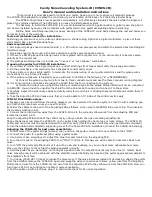
Requirement C is arbitrary. The light scattered by a particle depends on the shape and size of the particle, the
wavelength used for the measurement, and the angle of observation. Choosing 90º avoids the difficulties of
having to integrate the scattered light over all the scattering angles. An arbitrary observation angle works so
long as the sample turbidity is referred to the turbidity of a standard solution measured at the same angle. A
turbidimeter that measures scattered light at 90º is called a nephelometer.
Requirement D has a lot to do with the linearity of the
sensor. As Figures 5-5 and 5-6 show, particles lying
between the measurement zone and the detector can
scatter the scattered radiation. This secondary scatter-
ing reduces the amount of light striking the detector. The
result is a decrease in the expected turbidity value and
a decrease in linearity. The greater the amount of sec-
ondary scattering, the greater the non-linearity. Particles
in the area between the source and measurement zone
also reduce linearity.
ISO 7027 requirements are somewhat different from
EPA requirements. ISO 7027 requires that:
A. The wavelength of the interrogating light be 860±60nm, or for colorless samples, 550±30nm.
B. The measuring angle be 90±2.5º.
ISO 7027 does not restrict the maximum light path length through the sample. ISO 7027 calls out beam geom-
etry and aperture requirements that EPA 180.1 does not address.
Although ISO 7027 allows a laser, light emitting diode, or tunsten filament lamp fitted with an interference fil-
ter as the light source, most instruments, including the Clarity II, use an 860 nm LED. Because ISO 7027 tur-
bidimeters use a longer wavelength for the measurement, they tend to be more sensitive to larger particles
than EPA 180.1 turbidimeters. Turbidities measured using the EPA and ISO methods will be different.
2. TOTAL SUSPENDED SOLIDS. Total suspended solids (TSS) is a measure of the total mass of particles in a
sample. It is determined by filtering a volume of sample and weighing the mass of dried residue retained on
the filter. Because turbidity arises from suspended particles in water, turbidity can be used as an alternative
way of measuring total suspended solids (TSS). The relation between turbidity and TSS is wholly empirical and
must be determined by the user.
3. TURBIDITY UNITS. Turbidity is measured in units of NTU (nephelometric turbidity units), FTU (formazin tur-
bidity units), or FNU (formazin nephelometric units). Nephelometry means the scattered light is measured at
90º to the interrogating beam. Formazin refers to the polymer suspension typically used to calibrate turbidity
sensors. The units — NTU, FTU, and FNU — are equivalent.
4. TSS UNITS. The TSS value calculated from the turbidity measurement can be displayed in units of ppm or
mg/L. The user can also choose to have no units displayed.
5. SIGNAL AVERAGING. Signal averaging is a way of filtering noisy signals. Signal averaging reduces random
fluctuation in the signal but increases the response time to step changes. Recommended signal averaging is
20 sec. The reading will take 20 seconds to reach 63% of its final value following a step change greater than
the filter threshold.
6. BUBBLE REJECTION. When a bubble passes through the light beam, it reflects light onto the measuring pho-
todiode, causing a spike in the measured turbidity. The Solu Comp II analyzer has proprietary software that
rejects the turbidity spikes caused by bubbles.
FIGURE 5-6. Turbidity Sensor — ISO 7027
MODEL CLARITY II
SECTION 5.0
PROGRAMMING THE ANALYZER
27
















































